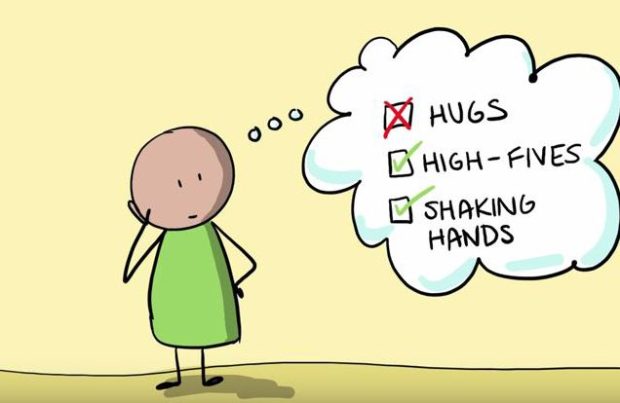Understanding & Discussing Consent in Classrooms
What is Consent?
Consent occurs when one person comprehensively understands and only then voluntarily agrees to the proposal or desires of another.
What is the Age of Consent in India?
Eighteen. This implies that any sexual activity between two minors is punishable under the law.This includes clicking and circulating sexually explicit photographs as well.
Why Should Consent be Taught In School?
Many children are raised without ever being taught the concept of bodily autonomy, or the right that each person has to decide what happens with their own body.
Learning to give and receive consent, or even just being aware about the concept of consent, can help children and young adults better understand their bodily rights while also giving them the courage to speak up if those rights are ever violated.
Teaching consent in the classroom could help students identify and have the courage to come forward about issues such as molestation and sexual assault.
Additionally, teaching consent can also help prevent sexual assaults. By teaching consent, youth can better understand that they do not have a right to another person’s body. Through your teachings, situations in which a young person misinterprets their partner’s silence, or instances where an individual initiates sex with someone who is unable to provide consent could be prevented.
When Should You Start Teaching Consent?
Teachers should teach consent in their classrooms as early as primary school. As an educator, you have the ability to empower young people by teaching them that they have control over their own body. Teachers have to take special consideration of their students’ age group when determining curriculum and teaching methods. Students’ maturity and comprehension levels will increase with age; thus, varying aspects of consent should be taught at different ages.
What Is the Best Way to Teach Students About Consent?
Ages 0-5
One lesson that many educators can use in order to teach consent involves tickling. Ask your students whether their parents or guardians like to tickle them; many of your students will affirmatively raise their hands. Continue to ask them if their parents or guardians immediately stop tickling them when asked to stop, and observe their responses; those students who respond that their tickler stops right away may already be learning about bodily autonomy and consent at home.
Following this initial observation, you can then move on to clearly explain that as soon as the person being tickled says “stop” or “no,” the tickling should always stop. Make sure your students understand that “no” and “stop” are words that should be honored unceasingly. Explain that this concept of consent is a right everyone has and can exercise in any circumstance, whether another person is tickling, pulling on hair, tapping, grabbing, etc. .
One specific way you can incorporate these concepts into the classroom environment is by encouraging your young students to clearly say “yes” or “no” in their everyday choices. For instance, teaching students to ask for permission before touching or hugging any classmates integrates the rule of consent into simple, everyday considerations.
Teach students that they must ask for permission from their classmate each time they wish to do these things as a way of emphasizing that consent can be revoked at any moment, including during the activity; just because their classmate shared a toy or gave them a hug once before does not mean they are obligated to share or hug again at subsequent times.
Ages 5-13
At this age, students will likely still be distanced from sexual activity or romantic relationships, you can typically continue to incorporate the concept of consent into everyday elementary school life.
Encourage them to watch their friends’ facial expressions during activity or play to be sure that everyone is enjoying it.
Teach your students that their actions and behaviors affect others, which can prepare them for a lifetime of empathy.
Teach your students that even taking or sharing photographs of other requires consent.
As your students get older, they will begin to explore their own sexualities and often obtain (usually inaccurate) information about sex from their groups of friends. When formal sex education begins, it is an appropriate time to expand your lesson on consent.
Teach your students that, until they reach the age of consent determined by law, any sexual intimacy others try to share with them is illegal, regardless of any verbal consent granted by the minor.
Ages 13-18
Explain that only “yes” means “yes.” And that they must not wait for your partner to say “no” to look for consent.
This is the age where sex-talk begins in gender-segregated environments, like locker rooms and sleep overs. Their crushes and desire are normal and healthy. But as teachers, need to not just stop kids from talking about other kids like they’re objects., you also need to tell them how to talk about people as whole individuals.
Explain that part of growing up is having changing hormones, and that hormones sometimes make it hard to think clearly. Sometimes that means our desire feels overwhelming, or that we’re angry, confused or sad. It’s common, and perfectly okay, to be overwhelmed or confused by these new feelings. Tell your students that no matter what they’re feeling, they can talk to you about it. But their feelings, desires and needs are no one’s responsibility but their own. They still need to practice kindness and respect for everyone around them.
Mentor teenage and college-aged boys and young men about what masculinity is. Men need to talk to boys about what’s good about masculinity. Ask what hasn’t been so good about our culture of masculinity in the past and How we can build a more inclusive form of masculinity that embraces all types of boys. These conversations can encourage a non-violent form of masculinity for the future.
Talk honestly about partying. Make it clear that they shouldn’t be drinking or using drugs. Explain that, under the influence, decisions sometimes become cloudy, and signals become unclear when we are impaired. How will you be sure that you are reading the other person’s signals accurately? –
Although it should be obvious, explain that a person who is drunk, high or otherwise impaired should not be touched, harassed or sexually assaulted.
Teach your students to stand up for, and seek help for, a fellow student appears to have had too much to drink.
Explain that the responsibility is never on the victim to have prevented his or her assault. It is always on the perpetrator to make the right decision and not harm anyone.
Finally, teens are thirsty for more information about sexual assault, consent and healthy sexuality. They want to learn, and they will find a way to get information about sex. If you are the one providing that information — lovingly, honestly and consistently — they will carry that information out into the world with them.
(source: SexInfoOnline, Huffington Post)










